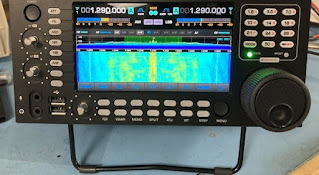Dear customers,
after a long development process, we are now on the verge of the realization of new 6th series RGO ONE HF homemade transceiver. The replacement of the existing platform and component base was necessary for many reasons – reaching the edge of the capabilities of old schematic elements, such as speed and workload, end of life for some crucial components and new more effective circuit solutions.
The new 6th series will allow the addition of new modules, such as long anticipated Audio filter DSP option (AF unit), TX speech processor, XVRT and RX antenna option, built-in audio USB card, which will allow the user to work digi Modes and many other options. New modules will not be compatible with older versions 5, 5+ and bellow.
In addition to the new modules and functionalities, the new system has significantly better behavior in terms of stability and speed. For example, the ATU module works significantly faster. New features are added too:
- New CW keying mode – ULTIMATIC mode is already in, and operators will be delighted using it. Of course, CURTIS A and CMOS B modes are available following strict rules and timing. Character auto-spacing for all keying modes is menu settable.
- Dual CAT port – New RGO ONE V6 utilizes dual port for CAT communication. USB 2.0 type A connector and TTL RS-232/UART on Canon DB15 connector (not available for first V6 Main Board PCB batch) for controlling peripheral devices such as power amplifiers, remote antenna tuners, antenna switches, and other.
Software updates will be extremely easy and friendly, with the user’s only task being to copy a set of two files to the radio, which will be read by the computer as a USB mass storage device (Flash drive – RGO ONE). Then radio will flash itself without operator intervention.
The main question that most owners of old RGO ONE series ask themselves is – can I update the software and hardware to the new 6th series. Of course, the answer to this question is YES. There will be a retrofit kit, which will mainly contain the two printed circuit boards (PCB) motherboard and processor (CPU) board on the front panel. All old daughter board modules, such as BPF, LO, SSB GEN, LPF, RF MIXER, IF/AF, VBF, NB, ATU, BPF160/60m and others will be compatible with the new 6th series. Hence, replacing both MB and CPU boards will give full functionality of the 6th series.
Expect the launch of the new 6th series RGO ONE in the period after Q1 of 2026, with requests and pre-orders still being accepted (till 31st December 2025) in the old form in Google Docs at the following link:
https://docs.google.com/forms/d/e/1FAIpQLSdN6ZqEZIdhCM6IDoCau3VDWjTtbEyCKlCqWgd2IH1UU6z-pg/viewform
Will keep base and module’s prices unchanged for those filled their pre-orders till December 31st 2025.
New optional modules will be introduced in stages after this period.
Meanwhile, for impatient users we still have some units from 5+ available with delivery within 10-14 days. Last 5+ series RGO ONE transceivers will have the latest IF/AF board, new LDMOS final power amplifier and all hardware mods implemented in.
























